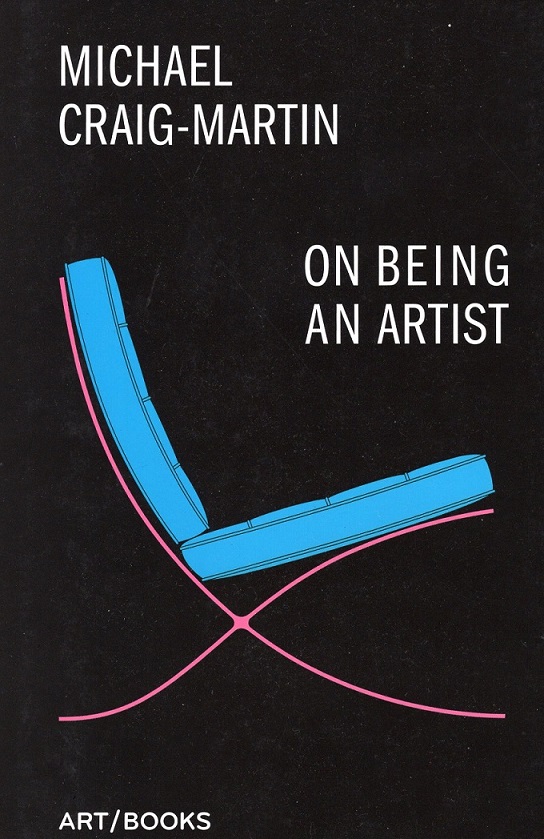Reviews & Articles
關於創意 | On being creative
John BATTEN
at 6:03pm on 21st April 2019


圖片說明:
1. Michael Craig-Martin, Bright Idea (2017) (© Michael Craig-Martin. 圖片提供: 藝術家、高古軒及香港半島酒店,圖片: Simon J Nicol)
2. Michael Craig-Martin的自傳式文集 On Being an Artist,倫敦 Art Books Publishing出版,2015年
Caption:
1. Michael Craig-Martin, Bright Idea (2017) (© Michael Craig-Martin. Courtesy the artist, Gagosian and The Peninsula Hong Kong. 圖片: Simon J Nicol)
2. Book cover of On Being an Artist by Michael Craig-Martin, Art Books Publishing, London, 2015
(Please scroll down for English version)
Michael Craig-Martin大部份時間都在美國成長和學習,最後於1960年代在耶魯大學藝術學院修讀美術畢業,同代人包括Frank Stella等。Craig-Martin的愛爾蘭藉父親在華盛頓哥倫比亞特區任農業經濟學家,但家人一直以都柏林和倫敦為家。年輕的Craig-Martin是當時少有的美術系畢業生,他來自歐洲但卻在美國接受教育,熟悉美國極富影響力的藝壇,也認識不少當時的傑出藝術家。然而,由於在美國找工作並不容易,他在25歲時決定離開美國遷居英國,展開教學生涯。
1966年時,紐約是國際藝術世界的中心,在那時離開紐約似乎是瘋狂的決定。但正如Craig-Martin在其自傳式文集《On Being an Artist》(作為藝術家,2015年)一書中解釋,這個決定讓他在一個將於未來五十年經歷完整、獨特革新的國家,特別是在倫敦這個城市當藝術家。他認為紐約市基本與1960年代無異,但倫敦卻是現時世界上最國際化、最富活力的城市。幸好該書在英國脫歐公投前已發行,這些主張還未需要認證!
Craig-Martin現在已是一位成功的資深英國概念藝術家,以其簡約的平面作品、畫作和雕塑見稱,主題通常都是日常物件。他的作品極少在香港參展,但於2017年,4米高的黃色管狀不銹鋼燈泡輪廓雕塑「Bright Idea」在香港半島酒店前庭展出。
現時,當代藝術市場對藝術與藝術家的主流討論,越來越由銷額、價目、人物與潮流主導,而非以意念、課題和美學先行,著作出版顯得特別合時。Craig-Martin認為,藝術展、市務推廣、公關人員和Instagram曝光度,某程度上反映了藝術家取得成功的現實。然而,藝術家與其作品的誠信必須為重中之中,而誠信始於藝術家維護自己的作品。
儘管Craig-Martin聚焦英國,他本身橫跨大西洋及遍及英美兩國的經驗,正正與很多專業和創意人才一樣,包括很多不時在世界各地研習、工作與生活的香港與內地設計師、建築師和藝術家。著作很能吸引各界,書中有不少短篇章的實用意見,也有很多有趣的小故事,還有教與學的方針。作者強調自律的重要性,也提及在情緒和思想上需要保持開放的心,更提醒我們一個明顯的道理:創意也是工作!
Craig-Martin一生都在創作藝術,也有不少時間從事教學,對創作界自然有其真知灼見。他其中一個意味深長的討論也適用於他自己的作品。他指出於1950年代,抽象表現主義在理論為本的藝評人率領下成為主導,至1960年代中期,這個重要角色由普普藝術、簡約主義和概念主義擔任。他指出:「對於與觀者對同場存在的特定作品,簡約主義在其即時個人體驗中尋找藝術意義,當中沒有參照另一次此前的經驗(沒有代述)、沒有暗示更高層次的經驗(不是形而上學)、也沒有承諾更深層的理性體會(沒有暗喻)……簡約主意為價值觀重設排序,在平凡經驗中找出深遠體會。」
這個說法中的真實性,可見於很多國際藝術家的作品,也可以在現今工業設計、家居建築、室內設計、家居裝飾與公共街道裝飾的不同面貌中找到。但是,在致力實現創意的原創性方面, Craig-Martin非常意識到在尋找「新」的時候,他經常「驚訝地發現我以為是新事物的往往存在已久。」
創意擁有漫長、複雜而多文化的歷史,對於任何藝想停滯不前的設計師、建築師、創作人或任何對世界與創意(或缺乏創意)感到爭扎的人來說,只需要簡單地回望過去就可以為創意找到靈感與新角度 ,還可以令生活更美好。
原文刊於《明報周刊》,2019年4月27日
On being creative
by John Batten
Michael Craig-Martin grew-up and studied most of his life in the USA, eventually graduating in fine art from the Yale School of Art in the early 1960s, alongside such contemporaries as Frank Stella. Craig-Martin’s Irish father worked as an agricultural economist in Washington DC, but home for the family was always seen as Dublin and London. The younger Craig-Martin was a rare fine art graduate: European, but American educated and familiar with New York’s influential art scene, knowing many of the time’s pre-eminent artists. He, however, decided to leave the USA aged 25 years old and live in the United Kingdom to begin a teaching career as work opportunities were few in the USA.
Removing himself from New York, at the time the centre of the international art world, in 1966 was a decision that seemed crazy, but as Craig-Martin explains in his autobiographical book of advice to artists, On Being an Artist (2015), it was a decision that allowed him to be an artist in a country, and particularly a city, London, that was to undergo a complete, and unique, makeover over the next fifty years. He argues that New York is essentially the same city it was in the 1960s, whereas London is now the most cosmopolitan, dynamic city in the world. Luckily published just before the Brexit referendum, the book did not need to qualify such assertions!
Craig-Martin is now a senior, successful British conceptual artist, particularly well-known for his pared-back minimal graphic work, drawings, and sculpture, often of everyday objects. He has rarely exhibited in Hong Kong, but in 2017 he did show a 4metre high yellow tubular stainless-steel outline sculpture (of a lightbulb), Bright Idea, prominently exhibited outside Hong Kong’s Peninsula Hotel.
This is a particularly timely book, as the contemporary art market, with its sales and prices and personalities and hype, rather than ideas, issues, and aesthetics, increasingly dominate mainstream discussion about art and artists. The role of art fairs and marketing and PR people and Instagram exposure is, as Craig-Martin acknowledges, part of the reality of being a successful artist. But, the integrity of the artist and their work must be paramount – and integrity starts with an artist defending their work.
Despite having a British focus, Craig-Martin’s own cross-Atlantic, his American-British experiences, mirrors many professionals and creative-types, including Hong Kong and mainland designers, architects and artists, who now readily study, work and live all around the world. The book has universal appeal with snippets of practical advice, amusing anecdotes, approaches to teaching and learning. He emphasizes the need for self-discipline, tempered by an openness of mind; and, he reminds us of the obvious: creativity is also work!
After a lifetime of making art, and considerable time teaching, Craig-Martin has considered opinions about the creative world. For example, in an argument that also supports his own artwork, he eloquently discusses the important role that Pop, Minimalism and Conceptualism have played since the mid-1960s, after the domination (often spearheaded by theory-based art critics) of Abstract Expressionism of the 1950s: “Minimalism seeks the meaning of art in the immediate and personal experience of the viewer in the presence of a specific work. There is no reference to another previous experience (no representation), no implication of a higher level of experience (no metaphysics), no promise of a deeper intellectual experience (no metaphor)….Minimalism reorders values. It locates profound experience in ordinary experience.”
The truth of this statement can be seen in the work of many international artists, and in aspects of today’s industrial design, residential architecture, interior design, home decoration and public street decoration. But, in striving for creative authenticity, Craig-Martin is very aware that when seeking the “new”, he was often “shocked to find how much of what was new to me had been around for so long.”
Creativity’s history is long, complex and multicultural – and for any ‘stuck’ artist, designer, architect, creative person or, indeed, anyone struggling with the world and its innovations (and lack of), then simply seeking out the past will give inspiration and a new angle for their own creativity – and better living.
Originally published in Ming Pao Weekly on 27 April 2019. Translation by Aulina Chan.
